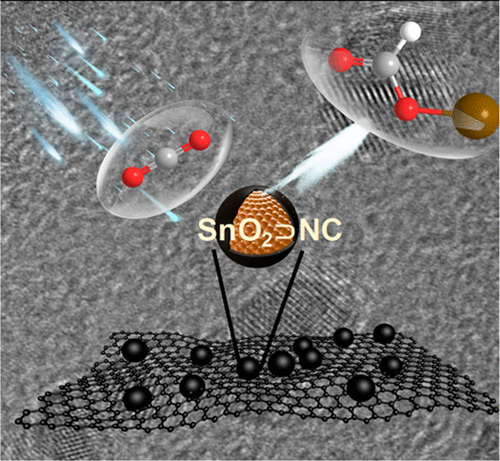当前位置:
X-MOL 学术
›
ACS Appl. Mater. Interfaces
›
论文详情
Our official English website, www.x-mol.net, welcomes your
feedback! (Note: you will need to create a separate account there.)
Nanoconfined Tin Oxide within N-Doped Nanocarbon Supported on Electrochemically Exfoliated Graphene for Efficient Electroreduction of CO2 to Formate and C1 Products
ACS Applied Materials & Interfaces ( IF 8.3 ) Pub Date : 2020-03-27 , DOI: 10.1021/acsami.9b18091 Yuanyuan Fu 1 , Tingting Wang 1 , Wanzhen Zheng 1 , Chaojun Lei 1 , Bin Yang 1, 2 , Jian Chen 3 , Zhongjian Li 1, 2 , Lecheng Lei 1, 2 , Chris Yuan 4 , Yang Hou 1, 2, 5
ACS Applied Materials & Interfaces ( IF 8.3 ) Pub Date : 2020-03-27 , DOI: 10.1021/acsami.9b18091 Yuanyuan Fu 1 , Tingting Wang 1 , Wanzhen Zheng 1 , Chaojun Lei 1 , Bin Yang 1, 2 , Jian Chen 3 , Zhongjian Li 1, 2 , Lecheng Lei 1, 2 , Chris Yuan 4 , Yang Hou 1, 2, 5
Affiliation

|
Developing low-cost and effective electrocatalysts for electrochemical reduction of CO2 (CO2ER) is critical to CO2 conversion and utilization. Herein, we report a novel two-dimensional (2D) confined electrocatalyst composed of core–shell structured tin oxide nanoparticles (NPs) encapsulated into N-doped carbon (NC) supported on electrochemically exfoliated graphene (SnO2⊃[email protected]) prepared by in situ carbonization of a 2-methylimidazole/SnO2 [email protected](vinyl pyrrolidone) (PVP)-modified EEG precursor. The SnO2 NPs with an average size of ∼10 nm are confined in the NC shells with a thickness of 0.7 nm derived from 2-methylimidazole. The resulting 2D confined electrocatalyst significantly enhances the CO2ER performance with a small onset potential of −0.45 V, and high Faradic efficiencies of 81.2 and 93.2% for HCOO– and C1 products at −1.2 V, respectively, which is far superior to other reported SnO2/carbon-based CO2ER hybrids. The superb CO2ER catalytic activity of the SnO2⊃[email protected] has resulted from the positive effect of N dopants and a strong confinement effect, which significantly expedites the CO2 adsorption associated with charge transfer from the NC to SnO2 NPs during CO2ER electrocatalysis.
中文翻译:

电化学剥落石墨烯支撑的N掺杂纳米碳中的纳米约束氧化锡,用于将CO 2有效电还原为甲酸酯和C1产品
开发用于电化学还原CO 2(CO 2 ER)的低成本有效催化剂对CO 2转化和利用至关重要。在此,我们提出一个新的二维(2D)限制电构成支撑在电化学剥离的石墨烯封装到N型掺杂碳(NC)核-壳结构的氧化锡纳米颗粒(NP)(的SnO 2制备⊃[电子邮件保护])通过原位碳化2-甲基咪唑/ SnO 2 [电子邮件保护](乙烯基吡咯烷酮)(PVP)修饰的脑电图前体。SnO 2平均大小约为10 nm的NP被限制在NC壳中,其厚度为0.7 nm,它是由2-甲基咪唑衍生而来的。所得的二维受限电催化剂显着提高了CO 2 ER性能,启动电位低至-0.45 V,HCOO –和C1产品在-1.2 V时的法拉第效率分别为81.2和93.2%,这远远优于其他产品报道了SnO 2 /碳基CO 2 ER杂化物。精湛的CO 2的ER催化活性的SnO 2 ⊃[电子邮件保护]导致选自N掺杂剂的积极效果和强烈的限制效应,这显著加速了CO 2吸附与CO 2 ER电催化过程中电荷从NC转移到SnO 2 NP有关。
更新日期:2020-03-27
中文翻译:

电化学剥落石墨烯支撑的N掺杂纳米碳中的纳米约束氧化锡,用于将CO 2有效电还原为甲酸酯和C1产品
开发用于电化学还原CO 2(CO 2 ER)的低成本有效催化剂对CO 2转化和利用至关重要。在此,我们提出一个新的二维(2D)限制电构成支撑在电化学剥离的石墨烯封装到N型掺杂碳(NC)核-壳结构的氧化锡纳米颗粒(NP)(的SnO 2制备⊃[电子邮件保护])通过原位碳化2-甲基咪唑/ SnO 2 [电子邮件保护](乙烯基吡咯烷酮)(PVP)修饰的脑电图前体。SnO 2平均大小约为10 nm的NP被限制在NC壳中,其厚度为0.7 nm,它是由2-甲基咪唑衍生而来的。所得的二维受限电催化剂显着提高了CO 2 ER性能,启动电位低至-0.45 V,HCOO –和C1产品在-1.2 V时的法拉第效率分别为81.2和93.2%,这远远优于其他产品报道了SnO 2 /碳基CO 2 ER杂化物。精湛的CO 2的ER催化活性的SnO 2 ⊃[电子邮件保护]导致选自N掺杂剂的积极效果和强烈的限制效应,这显著加速了CO 2吸附与CO 2 ER电催化过程中电荷从NC转移到SnO 2 NP有关。


















































 京公网安备 11010802027423号
京公网安备 11010802027423号